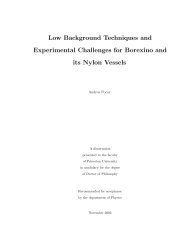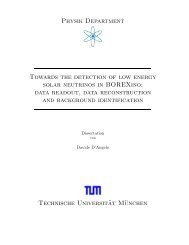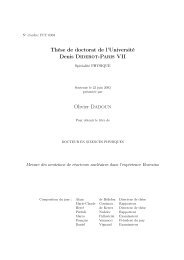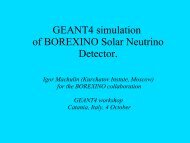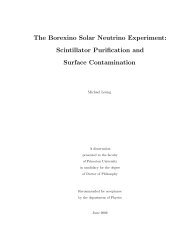Development of a Liquid Scintillator and of Data ... - Borexino - Infn
Development of a Liquid Scintillator and of Data ... - Borexino - Infn
Development of a Liquid Scintillator and of Data ... - Borexino - Infn
You also want an ePaper? Increase the reach of your titles
YUMPU automatically turns print PDFs into web optimized ePapers that Google loves.
4 Position Reconstruction <strong>of</strong> Scintillation Events<br />
4.4 Results Obtained with Simulated <strong>Data</strong><br />
Monte Carlo for Alpha, Beta <strong>and</strong> Gamma events<br />
To study the behaviour <strong>of</strong> the reconstruction code depending on the position, energy <strong>and</strong> decay<br />
type, I have simulated energy deposits from «, ¬ <strong>and</strong> decays at different positions in the<br />
BOREXINO <strong>and</strong> CTF detector.<br />
The simulation uses the scintillation decay times measured for different types <strong>of</strong> particle excitation<br />
(see table 4.1). The photon yield <strong>of</strong> the scintillator is assumed to be photons/MeV.<br />
This number reproduces approximately the photoelectron yield measured in the CTF (<br />
photoelectrons/MeV). The energy deposits <strong>of</strong> « <strong>and</strong> ¬ particles are assumed to be pointlike.<br />
The quenching <strong>of</strong> the alpha energies is included as measured in laboratory (see table 5.1). The<br />
energy <strong>of</strong> the « or ¬ decay is ‘translated’ into the corresponding number <strong>of</strong> photons which<br />
start at the point <strong>of</strong> the energy deposit with a time delay according to the scintillation decay<br />
time, <strong>and</strong> are tracked throughout the detector as described in section 4.2.<br />
The interaction <strong>of</strong> -rays in the scintillator is simulated including Compton scattering <strong>and</strong><br />
photo effect. Pair production plays no significant role in the energy range <strong>of</strong> interest (<br />
MeV). The travels through the detector with the speed <strong>of</strong> light (index <strong>of</strong> refraction ).<br />
At each interaction point, the number <strong>of</strong> photons corresponding to the energy <strong>of</strong> the scattered<br />
electron, start with a time delay according to the excitation by ¬ particles, <strong>and</strong> are tracked<br />
throughout the detector.<br />
Energy Dependence <strong>of</strong> the Spatial Resolution for Different Particles<br />
The approximation <strong>of</strong> the resolution <strong>of</strong> the spatial reconstruction for a point-like event is given<br />
by<br />
¡Ö Ø<br />
Ô ÒÔ<br />
where is the speed <strong>of</strong> light, Ø is the error <strong>of</strong> one time measurement <strong>and</strong> ÒÔ is the number <strong>of</strong><br />
measurements (= number <strong>of</strong> detected photons).<br />
The Monte Carlo simulation for the CTF leads to the following results, which are plotted in<br />
fig. 4.9:<br />
For beta events the Monte Carlo gives an energy dependence <strong>of</strong> the spatial resolution as<br />
Ü<br />
Ñ<br />
Ô ÒÔ<br />
Ñ<br />
Ô ÅÎ <br />
assuming a photoelectron yield <strong>of</strong> 300 photoelectrons per MeV in the CTF.<br />
For alpha events the spatial resolution is slightly worse, as more scintillation light is emitted<br />
at late times. The energy dependence is still approximately Ô ÒÔ.<br />
58



